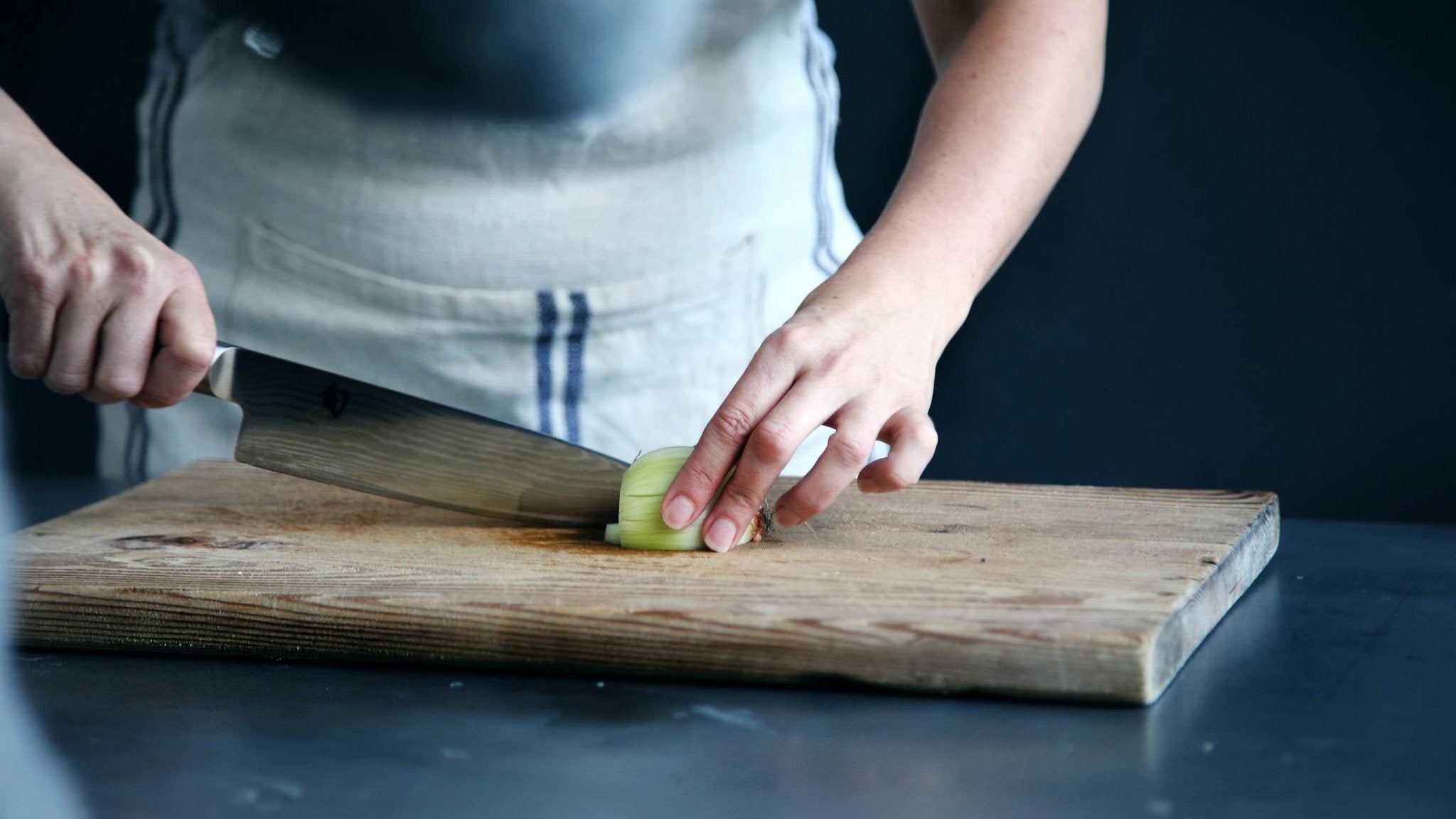The Basics: Cutting Techniques

Learn the different many ways to cut vegetables and herbs
The mise-en-place or pre-preparation is one of the most critical steps in the kitchen. Having all the ingredients and preparations ready will add rhythm to the kitchen flow, and at the time of service, nothing is missing.
That's why learning cutting techniques is super important for standardized preparation and speed. Most herbs and vegetables need to be prepared in advance – cleaned, peeled, sliced, or diced. So today, in this blog post, we will show you some cutting techniques.

The number 1 rule to remember is – Sharp knife, always!
The first tip for any cut is to have a sharpened knife. This detail is essential because you can make accurate cuts faster, and it's a great way to avoid hurting yourself with the knife. That's because, with a dull knife, it's more likely to slip and cut your fingers. Whenever you are cutting any food, you should have a sharpener on hand so that you can periodically sharpen the blade while you work. A whetstone is highly recommended, but a honing rod will do the trick as well!
At Chef Sac, we offer two types of knives: the 8 inch Chef Knife and the 7 inch Santoku. These two knives are sturdy, and the sharp blade is made of high-quality German stainless steel that is ice-hardened. Therefore, our blade won't rust or dull easily!

Here are some popularly known cuts in the culinary world:
1. Chop Vegetables
It's the most commonly used cut for many vegetables and herbs. For example, for mirepoix or similar aromatic ingredients that are to be strained and discarded, they are usually chopped. Herbs are chopped to garnish and finish the dish.
Slice and cut the vegetables at regular intervals until the cuts are small sized. If necessary, remove the root and stem tips and then peel the vegetables. Do not use the hardest parts of the herbs.

2. Chiffonade (Cut into Strips)
The chiffonade cut is used for leafy vegetables and herbs. The result is thin strips, often used as a garnish or for salads. For example, to make a slaw, remove the leaves and pile them. Then, make parallel cuts to get the strips. You can also roll the leaves into cylinders before cutting them, making cutting easier. Finally, the chef's knife is used to make very thin, parallel cuts to produce thin strips.

3. Rondelle (Circles)
Rondelle is the technique to cut vegetables into cylindrical discs of desired thickness. Some examples of vegetables that are cut in this fashion are carrots, cucumbers, and zucchini. Rondelles are easy to make. Clean and peel the vegetable, if necessary. Make parallel cuts at regular intervals. Guide the vegetable by pressing the tip with your thumb as you cut, which will help control the circles' size. You can carve the vegetable with a decorator to produce flower shapes to make a different shape.

4. Diagonal Cuts
This cut is often used to prep vegetables for stir-fries and other Asian dishes. Hold the knife to an angle through the food to make a diagonal cut. The wider the angle, the more elongated the cut surface. Continue making parallel cuts, adjusting the angle of the blade so that all pieces are approximately the same size.

The classic cuts of French cuisine will be shown in the next section. The dimensions indicated are only a guideline and can be modified as needed. Determine the size of the cut according to what the recipe calls for, the type of vegetable, the cooking time, and the desired appearance. Before chopping or cutting vegetables, you must clean them to remove the roots, center, stems, or seeds.
5. Julienne/Batonnet/Pont Neuf (Strip Cuts)
These are long, rectangular cuts. Cuts of Pommes de Frites (the French name for French fries) is an example of this cut. Other vegetables that are julienned are carrots, celery, and cucumbers. To make a Julienne cut, start cleaning and square the vegetable, leaving the edges straight. Next, cut both ends so that the block is even. Then cut slices lengthwise, making parallel cuts of the same thickness.
The standard sizes are:
- Julienne - 1⁄8 by 1⁄8 by 1–2 inches (0.3 cm × 0.3 cm × 3 cm–5 cm)
- Batonnet (little stick) - 1⁄4 by 1⁄4 by 2–2+1⁄2 inches (0.6 cm × 0.6 cm × 5 cm–6 cm)
- Pont neuf (french fries) - 1⁄3 by 1⁄3 by 2+1⁄2–3 inches (1 cm × 1 cm × 6 cm–8 cm) or 3⁄4 by 3⁄4 by 3 inches (2 cm) × 2 cm × 8 cm)

6. Brunoise (Cube Cuts)
Brunoise or diced vegetables are cubed cuts that can have different sizes. Different preparations require cubes of different sizes. The names given to the cubed cuts are Brunoise (standard cubes), Macédoine (medium cubes), Parmentier (large cubes), and Carré (extra-large cubes). Some usual vegetables for a brunoise are carrots, celery, onions, peppers, and turnips. The brunoise can be used as a garnish in many dishes, and it is often used to garnish consommé.

A brunoise cut is commonly used in stocks and soups to rapidly enrich the flavors and aromas transfer to the surrounding liquid. This happens due to the expansion in surface area compared to a traditional chopping method and is the best choice for recipes that do not benefit from the texture of chopped vegetables.
To start, clean and cut the vegetable as you would for the Julienne cut (previous session). Then, join the strips and cut sideways, at even intervals, thus forming the cubes.
The standard sizes for the cube cuts are six sides of the same size as below:
- Large dice: (or "Carré" meaning "square" in French); sides measuring approximately 3⁄4 inch (20 mm)
- Medium dice: (Parmentier); sides measuring approximately 1⁄2 inch (13 mm)
- Small dice: (Macédoine); sides measuring approximately 1⁄4 inch (5 mm)
- Brunoise: sides measuring approximately 1⁄8 inch (3 mm)

One of the ways to distinguish the beginner chef from the experienced one is how they approach cuts when it comes to vegetables and herbs. The goal is consistency and speed. With practice, you can achieve it!
Before starting the preparations, plan your work. Gather all the utensils you will need, including containers for prepared and unprepared vegetables and trimmings. Gather your knife and sharpener. Sharpen the knives at the beginning and during the work.
Der Säbel knives are perfect for slicing, dicing, and mincing with ease in any kitchen. The universal chef's knife will quickly become your favorite. Its ergonomic shape is designed for comfort, with a handle that rests gently on the blade edge to give chefs the perfect balance between comfort and control without causing harm. Our chef knife is here to support your chef journey! Click here to shop our knives.
- Tags: #How to Use Knives #Kitchen essential tools #Kitchen Knives #Knives for Beginners #Restaurant Tools #Serrated blade #Sharp Knives #Stainless Steel #Straight-edge #Use Knives #Using Ergonomics in the Kitchen Chef de Cuisine chef essentials Chef Knife chef sac chef tools Chefs gifts for culinary students interesting kitchen tools kitchen gifts knives Santoku Knife sharp knife sharpen knife Sous Chef Station Chefs types of chef
0 comments


